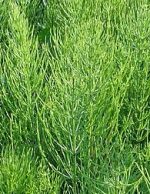 Common horsetail is a herbaceous perennial plant that bears spores rather than seeds and is more closely related to ferns than to seed bearing or flowering plants. Is is native to North America from Newfoundland west to Alaska and south to Georgia, Alabama, Texas, and California. Plant prefer full to part sun and moist to medium moist soil, and can be found in a variety of habitats including damp and open woodlands, pastures, fields, meadows, swamps, disturbed sites, and near the edges of streams.
Common horsetail is a herbaceous perennial plant that bears spores rather than seeds and is more closely related to ferns than to seed bearing or flowering plants. Is is native to North America from Newfoundland west to Alaska and south to Georgia, Alabama, Texas, and California. Plant prefer full to part sun and moist to medium moist soil, and can be found in a variety of habitats including damp and open woodlands, pastures, fields, meadows, swamps, disturbed sites, and near the edges of streams.
Description: Growing from branched creeping rhizomes than can penetrate the soil over six feet deep, common horsetail produces two distinct types of stems; fertile and sterile. The fertile stems appear in mid-spring and are two to twelve inches tall. They are tan, unbranched, and terminate in a cone -like structure that resembles a morel and carries the spores. The cone-like structure is up to 1 1/4 inches long, light brown, oblong, and rounded at the tip. After releasing their spores, the fertile stems wither away. The sterile stems appear from mid-spring to mid-summer and persist into fall. They are green, jointed, hollow, from two to twenty four inches long and carry up to twenty whorls of scale like, inconspicuous leaves at each node on at least the upper two-thirds of their length. The epidermis of both kinds of stems have regularly arranged, silicified projections. Plants spread primarily by rhizomes.
Control: Common horsetails are extremely difficult to eradicate because of their extensive rhizomes that can reproduce new plants even from small pieces left in the soil. Pulling , cutting or digging shoots and covering the area with a dense mulch like cardboard or newspaper for at least one growing season may be effective. Burning is not effective because of the rhizomes are deep, untouched by the fire, and quickly sprout. Most herbicides including glyphosate, are not effective but depending on the other vegetation, diclobenil, clorsulfuron, and sulfometuron may be useful.
T